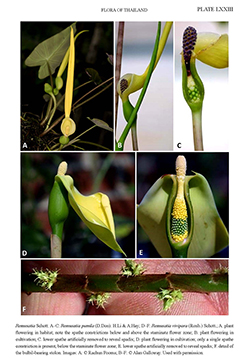e-Flora of Thailand
Volume 11 > Part 2 > Year 2012 > Page 266 > Araceae > Remusatia
2. Remusatia vivipara (Roxb.) Schott
in Schott & Endl., Melet. Bot.: 18. 1832; Syn. Aroid.:43. 1856; Gen. Aroid.: 36, t. 36. 1858; Prodr. Syst. Aroid.: 137. 1860; Engl. in A.DC. & C.DC., Monogr. Phan. 2: 496–497. 1879; Hook.f., Fl. Brit. India 6: 521–522. 1893; Krause in Engl., Pflanzenr. IV, 23E (Heft 71): 16–17, fig. 4. 1920; Gagnep. in Lecomte, Fl. Indo-Chine 6: 1133–1134. 1942; Hu, Dansk Bot. Ark. 23: 427–428. 1968; Li & Boyce in H.Li. et al., Fl. China 23: 71. 2010.— Arum viviparum Roxb., Hort. Bengal.: 65. 1814.— Caladium viviparum (Roxb.) Nees in Schott & Endl., Melet. Bot.: 18. 1832.— Colocasia vivipara (Roxb.) Thwaites, Enum. Pl. Zeyl.: 336. 1864. Plate LXXIII: D–F.
Accepted Name : This is currently accepted.
Synonyms & Citations :
Description : Medium to large, generally rather robust, epiphytic, lithophytic, rarely (in Thailand) terrestrial, seasonally dormant herb to 75 cm. Stem a depressed globose tuber 3.5–5 cm diam., partially epigeal to hypogeal, generally covered with the fibrous remains of petioles and cataphylls, often several tubers together; stolons stout, erect, simple or little-branched, 20–40 cm by 5 mm; bulbils ellipsoid, 0.5 by 2.5 mm, barbs recurved, ca 1.5 mm. Leaves few together; petiole stout, 19–45 cm; petiolar sheath occupying lower ¼; leaf blade oblong-ovate to ovatecordate, peltate, 11–33 by 7–20 cm, apex acute, base shallowly cordate, sinus 1.5–3 cm wide, basal ribs well-developed; primary lateral veins pinnate, forming submarginal collective vein very close to margin; secondary and tertiary laterals veins arising from the primaries at a wide angle; higher order venation reticulate, glossy on both sides green above, paler green abaxially. Inflorescences appearing when plants leafless, usually one per tuber but, in multi-tuber plants, many inflorescences developing simultaneously; peduncle 6–12 cm, subtended by 4 or more cataphylls, 3 by 15 cm long, concealing peduncle; spathe 8–16 cm long with a single constriction between the lower spathe and spathe limb; lower spathe ellipsoid, 3–5 by 1.3–2 cm, green; spathe limb obovate, acute, apiculate, narrowed to base, 5–11 by 5–9 cm, rather thick-textured, bright yellow, initially erect, then soon reflexed; spadix 3–4 cm, much shorter than the spathe, sometimes staminate zone barely exserted from the lower spathe; pistillate flower zone 1.5–2 cm by 7–9 mm, with 3–4 whorls of staminodes at apex and 1–2 whorls at base; ovary globoseellipsoid, green; stigma capitate, paler; sterile interstice slender, 1.1–2.5 cm, tapering upwards, covered with elongate synandrodes; staminate flower zone clavate-cylindrical, 1.5–2.2 cm by 4–7 mm, yellowish; synandria 2 by 3 mm, white. Fruiting spathe ellipsoid, splitting to reveal globose berries ripening red.
Thailand : NORTHERN: Chiang Mai, Nan, Tak; NORTH-EASTERN: Loei; EASTERN: Chaiyaphum; SOUTH-WESTERN: Kanchanaburi, Ratchaburi; PENINSULAR: Ranong.
Distribution : W, E & NE tropical Africa and Madagascar through the Arabian Peninsula to India and Sri Lanka northwards along the Himalaya (including Nepal – type), SW China, through Indochina to Taiwan (type of Remusatia formosana).
Ecology : Seasonally dry evergreen or mixed deciduous upper hill to lower montane forests, occasionally on limestone.
Vernacular : Bon mai (บอนไม้)(Northern); wan subin (ว่านสุบิน)(Chiang Mai); khue-sa (คึสะ)(Karen-Kamphaeng Phet).
Notes: A common species in the wild but almost never collected flowering. The lack of flowering specimens has been used to suggest that Remusatia vivipara is a shy-flowering plant in the wild, and various fanciful theories linked to a ‘preference’ for vegetative dispersal via the barbed bulbils have been put forward. The other Remusatia species, all of which produce barbed bulbils,are frequently collected in flower so it seems more probable that the lack of fertile collections of R. vivipara relates to its distribution in places which used to be inaccessible at the onset of the wet season when R. vivipara flowers. Remusatia pumila flowers when the plant is in full growth and the rains less intense and is thus more likely to be seen in flower. In cultivation R. vivipara flowers profusely.

